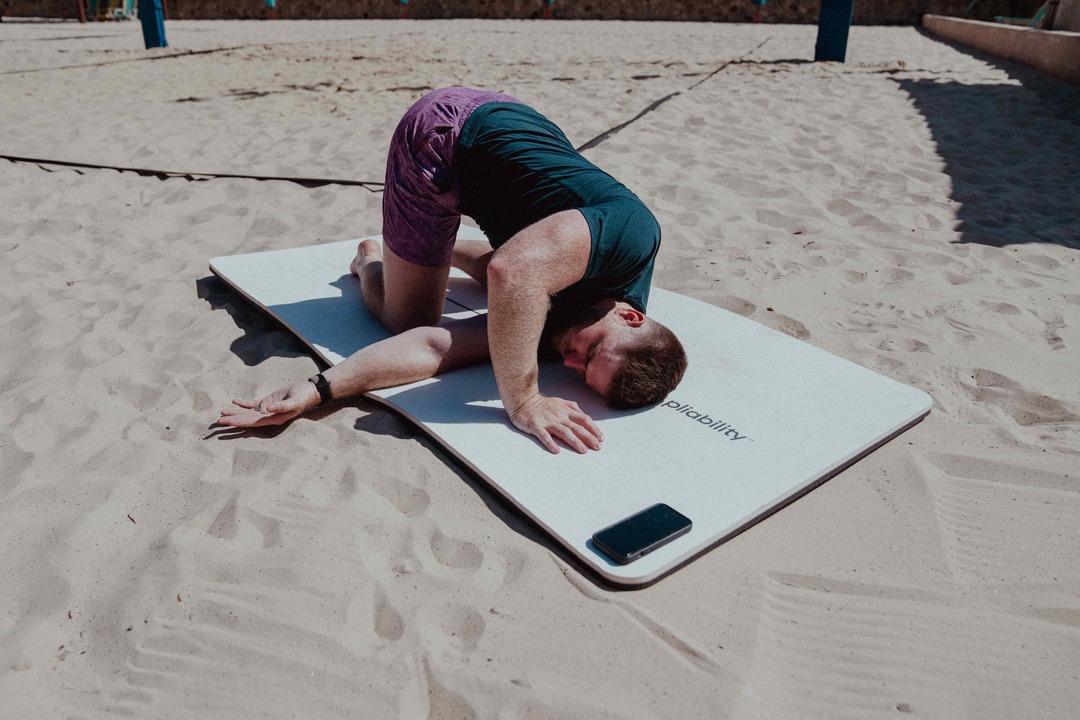You’ve been training hard, focusing on improving your strength and performance. Then, it happens. You strain a muscle. No matter how mild it is, the injury sets you back and halts your progress. Muscle strains can take time to heal, but you don’t have to sit idle and let recovery happen on its own. Using the best recovery tools for athletes, such as massage guns, compression gear, and cold therapy—can significantly enhance your healing process. Several strategies can help speed up muscle strain recovery so you can regain full strength, move without pain, and get back to your workouts or daily activities without setbacks. This article will help you with valuable insights on How to Speed Up Muscle Strain Recovery.
Pliability’s mobility app can help you achieve your muscle strain recovery goals by guiding you through targeted routines to reduce muscle tension, restore flexibility, and improve mobility, so you can get back to your activities as quickly as possible.
What are the Common Types of Muscle Strains?

A muscle strain, or pulled muscle, occurs when your muscle is overstretched or torn. This usually occurs as a result of fatigue, overuse, or improper use of a muscle. Strains can happen in any muscle, but they’re most common in your lower back, neck, shoulder, and hamstring, the muscle behind your thigh.
These strains can cause pain and may limit movement within the affected muscle group. Mild to moderate strains can be successfully treated at home with ice, heat, and anti-inflammatory medications. Severe strains or tears may require medical treatment.
A Spectrum of Immediate Symptoms
You’ll usually feel a muscle strain as it occurs. Symptoms include:
- Sudden onset of pain
- Soreness
- Limited range of movement
- Bruising or discoloration
- Swelling
- A “knotted-up” feeling
- Muscle spasms
- Stiffness
- Weakness
From Mild Stiffness to Severe Immobility in Muscle Strains
A torn muscle may feel slightly stiff but still flexible enough for use in a mild strain. A severe muscle strain is when the muscle is severely torn, resulting in pain and very limited movement. The symptoms of mild to moderate muscle strains usually go away within a few weeks, but more severe strains may take months to heal.
Muscle Strain vs. Pulled Muscle
A muscle strain is the same as a pulled muscle or a muscle tear. Since it’s an identical injury, there are no differences in symptoms or treatments. All three terms are used interchangeably.
What Causes Muscle Strains?
An acute muscle strain is when your muscle tears suddenly and unexpectedly. Such tears can occur either from injuries or trauma. This can be due to:
- Not warming up properly before physical activity
- Poor flexibility
- Poor conditioning
- Overexertion and fatigue
Everyday Activities and Unexpected Muscle Strains
There’s a misconception that only rigorous exercises and workouts of high intensity cause muscle strains. According to Johns Hopkins Medicine, muscle strains can even occur from walking. An acute strain can happen when you:
- Slip or lose your footing
- Jump
- Run
- Throw something
- Lift something heavy
- Lift something while in you’re in an awkward position
Understanding the Acute and Chronic Pathways to Muscle Injury
Acute muscle strains are also more common in cold weather. This is because muscles are stiffer in lower temperatures. It’s essential to take extra time to warm up in these conditions to prevent strains. Chronic muscle strains are the result of repetitive movement. This can be due to:
- Sports like rowing, tennis, golf, or baseball
- Holding your back or neck in an awkward position for long periods, such as when you work at a desk
- Poor posture
What Are the Grades and Severity of Muscle Strains?
While all muscle strains hurt, some are more serious than others. Here's a quick look at the grades of muscle strains:
Grade 1 Muscle Strain
This is a mild strain with minimal impact on muscle strength or motion.
Grade 2 Muscle Strain
While this is more serious than a grade 1 muscle strain, your muscle hasn't wholly torn. Still, you'll have less strength and motion in that muscle, and maybe some swelling and bruising. It may take 2-3 months to recover.
Grade 3 Muscle Strain
This is a serious injury where your muscle tears into two pieces or shears away from the tendon. You won't be able to use the muscle and will have significant pain, swelling, and bruising. This type of injury might need to be repaired with surgery.
Related Reading
- What Is Active Recovery
- Why Is Recovery Important for Athletes
- Is Yoga Active Recovery
- Should You Be Sore After Every Workout
- Calves Sore After Running
- Which Muscles Recover the Fastest
- Why Are Ice Baths Good for Muscle Recovery
- What to Do on Recovery Days
- Why Is It Important to Include Recovery Time in a Workout Program?
- What to Drink for Muscle Recovery
How to Speed Up Muscle Strain Recovery

1. Keep Moving: Why a Little Movement Goes a Long Way
The concept of "rest is best" has evolved in the physical therapy world. We used to think that rest, ice, compression, and elevation (RICE) were the gold standard for healing from injury like a muscle strain. Still, we now prefer to recommend P.E.A.C.E. and L.O.V.E. PEACE stands for protect, elevate, avoid unnecessary medications, compress, and educate. LOVE stands for load, optimism, vascularization, and exercise.
Beyond Immobilization
It’s a tad technical, but it boils down to this: It's crucial to incorporate gentle movement early on in the recovery process. Many people mistakenly assume that they need to completely immobilize (stop moving) an injured area. While you do want to avoid aggravating movement in the first 24 to 48 hours after a muscle strain, complete lack of movement can slow your recovery.
Instead, engage in gentle movement that feels tolerable (such as walking or stretching) and gradually increase the amount you ask your body to do.
2. Ice and Heat: A Hot and Cold Approach to Recovery
Ice and heat can be helpful tools in managing discomfort from a muscle strain. Ice helps reduce inflammation and swelling. It narrows blood vessels, which limits blood flow to the injured tissue and helps decrease initial swelling and pain. This can be useful in the first 24 to 48 hours after the injury. After that, heat tends to be more beneficial.
Harnessing Heat for Muscle Recovery and Comfort
Heat helps increase blood flow to the area, bringing oxygen and nutrients that support healing. It also helps relax tight or stiff muscles, which often happens as a protective response to the strain. I recommend using heat before exercise therapy to make it easier to move and help reduce discomfort. Heat can also be beneficial before bedtime if pain interferes with sleep.
3. Take Care of the Rest of You: Whole Body Recovery
Healing from a muscle strain isn’t just about focusing on the injured area. Your entire body plays a role in recovery, and taking a well-rounded approach can help speed up the process. First, stay hydrated. Water is essential for transporting nutrients to your muscles and flushing out waste products that accumulate during healing.
Nutrition & Flexibility: Fuel & Flex
It also helps keep your muscles and tissues flexible, making movement easier and reducing the chance of further injury. Along with hydration, eating nutritious foods supports healing. Focus on fruits, vegetables, protein-rich foods (lean meats, beans, and legumes), and healthy fats (avocado, olive oil, and fatty fish).
Rest & Sleep: Restorative Sleep
These nutrients help rebuild muscle tissue, reduce inflammation, and provide the energy your body needs to heal efficiently. Prioritize rest and sleep. Your body repairs damaged tissues while you sleep, so getting enough quality rest is crucial for muscle recovery. Aim for seven to nine hours of sleep each night to give your body the time it needs to repair and regenerate muscle fibers.
4. Stay Hydrated: Water is Key
Hydration is key to injury or strain recovery. Water flushes toxins from the body, nourishes cells, relieves muscle stiffness and stress, and maintains pH equilibrium. Drinking plenty of water keeps our bodies healthy, and after an injury, you should take adequate water as dehydrated muscles heal more slowly. Drink 16 to 24 ounces of water per pound you lose while exercising. If you dislike the taste of water, organic mint water or flavored water will also do the trick.
5. Heat Therapy: When to Use Heat on an Injury
First, R.I.C.E. therapy should be done for a pulled muscle (rest, ice, compression, and elevation). Heat should be avoided for 72 hours to prevent puffy, inflamed skin. After 72 hours, adding heat to a therapy regimen can improve blood flow and circulation.
Optimizing Muscle Repair Post-Icing
After icing, utilize heat to speed muscle healing as heat therapy reduces edema and inflammation while keeping muscles supple. Heat therapy dilates arteries and boosts blood flow (which should actually be warm, not hot), resulting in relaxed stiff muscles. Better circulation provides more oxygen, nutrients, and lactic acid for muscle regeneration.
For the best results, use a massage chair with heat functions. A heated massage chair speeds up muscle mending and provides a full-body experience.
6. Increase or Improve Sleep: Rest to Recover
If given the right conditions, your body can self-heal in many ways. Adequate rest is crucial to accident recovery (and the "R" in the "RICE" treatment method). Most people require 7-9 hours of sleep, but extra sleep may be necessary for those with active lifestyles. You need rest, whether you have a muscle strain, a torn tendon, or a broken bone.
When sleeping on your back, place a pillow between your knees to reduce back, hip, or knee pain. Invest in supportive pillows and try not to sleep on your uncomfortable side. Another option is to lie on your stomach with a pillow beneath your abdomen.
7. Lifestyle Changes: How Your Habits Affect Recovery
Lifestyle considerations cover many topics, including diet, sleep, interests, and drug usage. Even if lifestyle variables are complex, you can enhance your health. Smoking and excessive alcohol usage can worsen inflammation and slow healing.
Smoking/Drinking): Substance Sabotage
Many patients feel smoking or drinking might relieve their symptoms, but this just prolongs healing and increases their risk of addiction. Tobacco and alcohol are unhealthy, and you should limit both when healing from a muscle injury. Alcohol lowers protein synthesis and glycogen replacement, and tobacco can damage the musculoskeletal system, but there's no link to injury rehab.
Sleep: Restorative Recovery
You shouldn't risk muscular damage while recovering from an injury. Reducing the frequency or amount of these substances can help rehabilitation for injuries. Adequate sleep helps injured patients recover. Even if you sleep in a less-than-ideal position for your injury, maximizing your sleep will help you heal (remember that specific orders from your doctor or physiotherapist may override this general concept).
8. Foods for Recovery: Nutrition to Heal Muscle Strains
Proper nutrition and hydration are important for health and fitness, but there is no specific diet for healing muscle injury. Nevertheless, sugary and processed foods should be avoided, as sugar, a simple carbohydrate, might hinder the body's healing ability. The evidence on processed foods is less clear.
These are a few foods you should consider taking to speed up muscle recovery:
Protein-rich Foods
Protein is essential for numerous human components, including the muscles. Protein-rich diets may help you recover faster when you return to exercising. You should boost your protein intake when healing from a muscle injury, and taking whey or collagen supplements can increase your protein intake without changing your diet.
Protein's Protective Role
Even if you're not exercising much, keep eating protein as protein inefficiencies during recovery can impair muscle mending and cause inflammation. A sports injury often requires immobilization, which may affect muscle mass and strength. Taking protein can minimize this loss. Protein-rich diets may reduce inflammation, which can slow recovery.
Protein for Regaining Strength
Increasing your protein intake when training the newly repaired body part promotes muscle regrowth. Because of these reasons, you should regularly eat high-protein meals. How you distribute these items throughout the day also matters. Pre-bedtime protein may help your body create muscle while you sleep.
Fueling Recovery and Weight Management
After an injury, eat protein-rich meals and snacks to decrease muscle loss and promote recuperation. Healing often requires immobilization or restricted use of an injured body component which affects muscle mass and strength. To manage your weight throughout rehabilitation, you may wish to eat differently than before your injury. Vitamin C, magnesium, and zinc, all crucial for recovery, are abundant in high-fiber diets.
Vitamin C's Healing Power
Vitamin C can be found in fruits and vegetables. Vitamin C helps your bones, muscles, skin, and tendons by producing collagen, a coenzyme needed for tissue repair and regeneration. Vitamin C heals wounds and helps the body heal after an injury. It is easily accessible and can be found in:
- Citrus fruits
- Bell peppers
- Dark leafy greens
- Kiwi
- Broccoli
- Berries
- Tomatoes
- Papaya
Vitamin C supplements have a mixed record for boosting athletic performance or accelerating recuperation.
9. Physiotherapy Assessment and Treatment: When to Seek Help
A physiotherapist can diagnose your condition, teach you how to manage it, and recommend the best treatment. Local physiotherapists can help you determine the optimal recovery plan. Guidance and encouragement can speed up people's healing, and your doctor may advise extra therapies to help you recover faster and return to your hobbies.
Rehabilitation Techniques
Physiotherapists treat muscular injuries using many methods, including:
- Soft tissue release
- Joint mobilizations
- Electrotherapeutic modalities
- Transcutaneous nerve stimulation (TENS)
- Neuromuscular electrical stimulation (N.M.E.S.)
- Interferential Current Therapy (IFC)
- Electroacupuncture
Related Reading
- Natural Muscle Recovery
- Is Sauna Good for Muscle Recovery
- Is Swimming Good for Recovery
- Benefits of Active Recovery
- How to Speed Up Muscle Recovery
- How to Get Rid of Sore Muscles Overnight
- Should You Workout When Sore
- Active Recovery vs Rest Day
- Active vs Passive Recovery
- Muscle Recovery Time by Age
- Recovery Methods for Athletes
How to Prevent Muscle Strains

Sitting too long can lead to stiff muscles that are more prone to injury. If you have a desk job, take frequent breaks to move around and change positions. Use a chair that supports your lower back or a pillow for support. Try to keep your knees level with your hips.
If you spend a long time in one position, try to alternate putting one foot and the other on a low footstool. This can help decrease stress on your back muscles.
Mind Your Posture
Maintaining good posture when standing and sitting helps prevent muscle strains and other injuries. If you spend a long time in one position, try alternately putting one foot and then the other on a low footstool. This can help decrease stress on your back muscles.
Lift Objects Carefully
Lifting objects improperly can lead to muscle strains, especially in the back. Keep your back straight, bend at the knees, and always lift with your legs to avoid injury. Hold the weight close to your body. Don’t lift and twist at the same time.
Reduce Your Risk of Falls
Taking precautions to prevent falls can help you avoid muscle strains and other injuries. For example, hold handrails on stairways, avoid slippery surfaces, and keep your floors uncluttered.
Lose Weight If You’re Overweight
Carrying excess weight can increase your risk of muscle strains and other injuries. Losing weight if you’re overweight can decrease the stress on your muscles and help you avoid injuries.
Strength Training
Weak muscles are more prone to injury, but strengthening them through weight lifting, yoga, or cycling makes them more resilient to stress. Doing strength training at least twice a week for 20 minutes or more is best. Talk to your doctor before you start a new exercise program.
Wear Proper Shoes
Wearing shoes that fit correctly can help you maintain good posture and avoid muscle strains. If you have any specific foot problems, talk to your doctor about the shoes best for you.
Warm Up Before Exercise
Regular exercise can keep your muscles healthy and strong, but proper techniques are also crucial in preventing muscle strains. Always stretch and warm up before engaging in physical activity.
Cool Down After Exercise
Similarly, take the time to stretch after each workout or session of physical activity to prevent muscle stiffness. If you’re new to exercising, start slowly and build up your activity a little at a time.
Listen To Your Body
You must understand your body’s limitations. If something doesn’t feel right during an activity, stop immediately.
Improve Your Flexibility with Our Mobility App Today | Get 7 Days for Free on Any Platform
Pliability offers a fresh take on yoga tailored for performance-oriented individuals and athletes. Key features include:
- A vast library of high-quality videos designed to improve flexibility, aid recovery, reduce pain, and enhance range of motion.
- Daily updated custom mobility programs for optimizing their health and fitness.
- A unique body-scanning feature to pinpoint mobility issues
Whether you're limited by pain or movement restrictions, Pliability complements your fitness routine and helps you move better.
Sign up today for a 7-day free trial on iPhone, iPad, Android, or via our website to improve flexibility, aid recovery, reduce pain, and enhance range of motion with our mobility app.
Related Reading
- Which Magnesium Is Best for Muscle Recovery
- Hot or Cold Bath for Muscle Recovery
- Benefits of Massage Gun
- Foam Roller Benefits
- Chocolate Milk for Muscle Recovery
- How to Speed Up Muscle Strain Recovery in Back
- Causes of Poor Muscle Recovery
- Active Recovery Workout
- Active Recovery Stretches
- Best Recovery Tools for Runners
- Best Vitamins for Muscle Recovery
- Best Foods for Muscle Recovery
- Workout Recovery Tools







